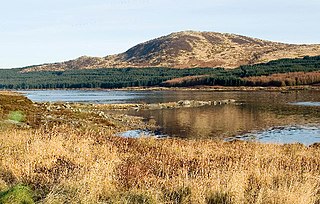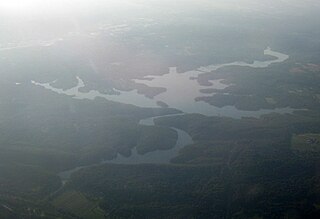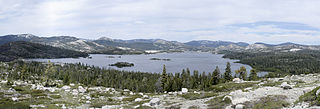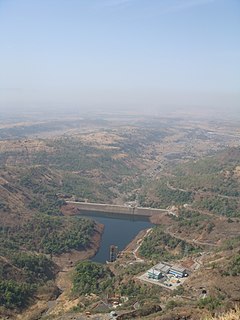
The Cowlitz River is a river in the state of Washington in the United States, a tributary of the Columbia River. Its tributaries drain a large region including the slopes of Mount Rainier, Mount Adams, and Mount St. Helens.

A diversion dam is a dam that diverts all or a portion of the flow of a river from its natural course. Diversion dams do not generally impound water in a reservoir; instead, the water is diverted into an artificial water course or canal, which may be used for irrigation or return to the river after passing through hydroelectric generators, flow into a different river or be itself dammed forming an onground or groundwater reservoir or a storm drain.

Loch Cluanie is a loch in the Northwest Highlands of Scotland at the south-east end of Glen Shiel. It is a reservoir, contained behind the Cluanie Dam, constructed by Mitchell Construction and completed in 1957 as part of the North of Scotland Hydro-Electric Board's Glenmoriston project to generate hydroelectricity. Water feeds the dam from the west via two flows, from a tunnel from the dammed Loch Loyne and via the River Moriston.

A reservoir is, most commonly, an enlarged natural or artificial lake, pond, or impoundment created using a dam or lock to store water.

Loch Doon is a freshwater loch in Carrick, Scotland. The River Doon issues from its northern end, while the loch itself receives waters from Gala Lane and Loch Enoch via Eglin Lane.

Sir Adam Beck Hydroelectric Generating Stations are two hydroelectric generating stations in Niagara Falls, Ontario, Canada. Sir Adam Beck Generating Station I, Sir Adam Beck Generating Station II and the Sir Adam Beck Pump Generating Station are all owned by Ontario Power Generation. Following the development of several smaller generating stations around Niagara Falls in the late 19th and early 20th centuries, the Province of Ontario authorized the construction of first major publicly owned generating station in the province. At the time it was built, it was the largest hydroelectric generating station in the world.

The Robert Moses Niagara Hydroelectric Power Station is a hydroelectric power station in Lewiston, New York, near Niagara Falls. Owned and operated by the New York Power Authority (NYPA), the plant diverts water from the Niagara River above Niagara Falls and returns the water into the lower portion of the river near Lake Ontario. It uses 13 generators at an installed capacity of 2,675 MW (3,587,000 hp).

Run-of-river hydroelectricity (ROR) or run-of-the-river hydroelectricity is a type of hydroelectric generation plant whereby little or no water storage is provided. Run-of-the-river power plants may have no water storage at all or a limited amount of storage, in which case the storage reservoir is referred to as pondage. A plant without pondage is subject to seasonal river flows, thus the plant will operate as an intermittent energy source. Conventional hydro uses reservoirs, which regulate water for flood control, dispatchable electrical power, and the provision of fresh water for agriculture.

The Loch Raven Reservoir is a reservoir that provides drinking water for the City of Baltimore and most of Baltimore County, Maryland. It is fed by the Big Gunpowder Falls river, and has a capacity of 23 billion US gallons (87,000,000 m3) of water.

Dunalastair Water is an entirely man made reservoir in Scotland which lies between Loch Rannoch and Loch Tummel in Strath Tummel in Perth and Kinross council area. The loch provides water power for the Tummel hydroelectricity power station and has the reputation as one of the best wild trout fishing locations in the United Kingdom.

The River Add is a river which runs through Argyll and Bute on the West of Scotland. Historically, it was known as the river Airigh but to avoid confusion with the River Aray|Aray]], it was renamed the River Add.

Kığı Dam is a rock-fill embankment dam on the Peri River in Bingöl Province, Turkey. Its primary purpose is hydroelectric power generation and is the first dam in the Peri River cascade, serving as the headwaters. Construction began in 1998 and is backed by the Turkish State Hydraulic Works. When commissioned, it will support a 180 MW power station. Water from the reservoir will be diverted to an underground power station downstream via an 8.5 km (5.3 mi) long tunnel. In August 2015, suspected Kurdistan Workers' Party militants set fire to three cement trucks associated with the dam construction site. In January 2016, the dam was completed and the reservoir began to impound water.

Loch Mhòr is a loch in the traditional county of Inverness-shire in the Scottish Highlands. It occupies much of the wide floor of Stratherrick which runs roughly parallel to Loch Ness, around 3 mi (4.8 km) to its southeast. A generally shallow body of water 179 m (587 ft) above Loch Ness, Loch Mhòr achieves a depth in excess of 20 m (66 ft) towards its southern end.

The Pandoh Dam is an embankment dam on the Beas River in Mandi district of Himachal Pradesh, India. Under the Beas Project, the dam was completed in 1977 and its primary purpose is hydroelectric power generation. Part of a run-of-the-river power scheme, it diverts the waters of the Beas to the southwest through a 38 km (24 mi) long system of tunnels and channels. The water is used for power generation at the Dehar Power House before being discharged into the Sutlej River, connecting both rivers. The power house has an installed capacity of 990 MW. The system diverts 256 cumecs of Beas waters to the Satluj River. The project was completed in 1977.

Blackmill Loch is an impounding reservoir, in Argyll and Bute, Scotland. The loch was constructed in 1964 and is one source of freshwater for the Lochgair Hydroelectric Scheme. The loch feeds the River Add, when not diverted for hydroelectric purposes. It is one of the two significant forest lochs to the north of Loch Glashan, the other being Loch Bealach Ghearran.

The Upper American River Project (UARP) is a hydroelectric system operated by the Sacramento Municipal Utility District (SMUD) of Sacramento, California in the United States.

The Maskeliya Dam is a large gravity dam at Maskeliya, in the Central Province of Sri Lanka. Along with the Castlereigh Dam, the dams are the highest point and beginning of the Laxapana Hydropower Complex, involving a number of dams, penstocks, and hydroelectric power stations. The dam creates the Maskeliya Reservoir over the route of Maskeliya Oya, a major tributary of the Kelani River, which is the 4th longest in the country.

Ghatghar Dam refers to two associated gravity dams built using roller-compacted concrete, the first use in India. They are situated in Ghatghar village in Ahmednagar district Maharashtra, India. Both dams create a lower and upper reservoir for the 250 MW pumped-storage hydroelectric power station. The upper Ghatghar dam is 15 m (49 ft) tall and on the Pravara River, a tributary of Godavari river. The lower Ghatghar dam is 86 m (282 ft) tall and located on the Shahi Nalla which is a tributary of Ulhas River to the south west of the upper reservoir in a steep valley. The hydro power project diverts Godavari river basin water outside the basin area to a west flowing river of Western ghats.

The Burç Bendi Dam is a gravity dam on the Göksu River, near the village of Burç in Adıyaman district, Adıyaman Province, Turkey. Its primary purpose is hydroelectric power generation and it supports a 27.9 MW run-of-the-river power station. Construction on the dam began in January 2008 and it was fully operational by 3 November 2010. The 57 m (187 ft) tall concrete dam withholds a reservoir of 26,600,000 m3 (21,600 acre⋅ft). Water is diverted through a 536 m (1,759 ft) long tunnel to the power station downstream which contains three 9.3 vertical Kaplan turbine-generators. It is owned and operated by ČEZ Group.




















